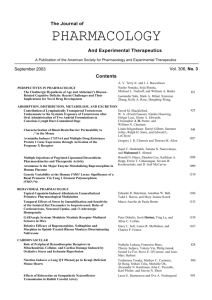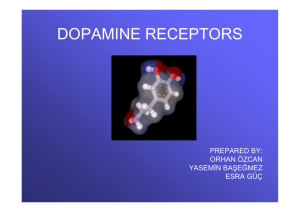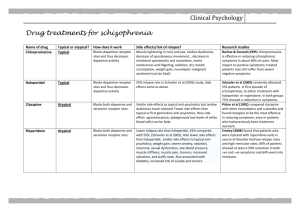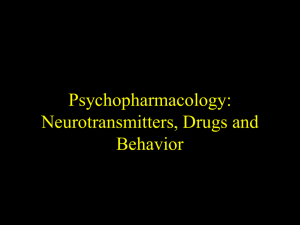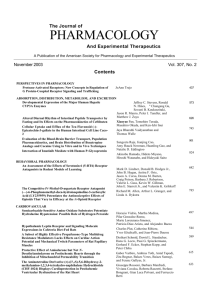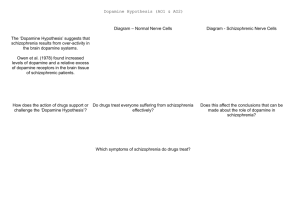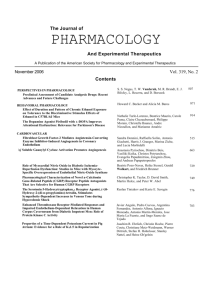Document 10842545
advertisement
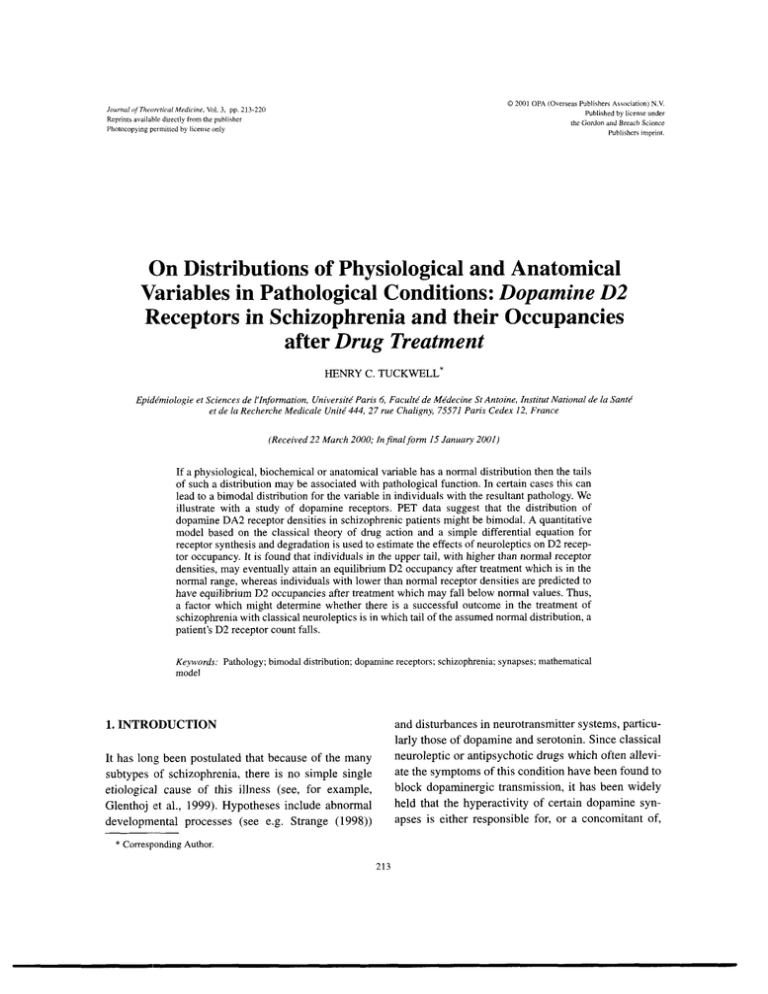
02M)l OPA (Overseas Publishers As~ociation)N.V. Journal of Theurdcal Med~cme,Vol. 3, pp. 213-220 Reprints available drectly from the publisher Photocopymg permtted by license only Published by license under the Gordon and Breach Science Publishers mprint. On Distributions of Physiological and Anatomical Variables in Pathological Conditions: Dopamine 0 2 Receptors in Schizophrenia and their Occupancies after Drug Treatment Epidt;miologie et Sciences de I'lnformation, Universite'Paris 6, Faculte'de Me'decine St Antoine, Irtstitut National de la Sante' et de la Recherche Medicale Unite'444, 27 rue Chaligny, 75571 Paris Cedex 12. France (Received 22 March 2000; Injinal form 15 January 2001) If a physiological, biochemical or anatomical variable has a normal distribution then the tails of such a distribution may be associated with pathological function. In certain cases this can lead to a bimodal distribution for the variable in individuals with the resultant pathology. We illustrate with a study of dopamine receptors. PET data suggest that the distribution of dopamine DA2 receptor densities in schizophrenic patients might be bimodal. A quantitative model based on the classical theory of drug action and a simple differential equation for receptor synthesis and degradation is used to estimate the effects of neuroleptics on D2 receptor occupancy. It is found that individuals in the upper tail, with higher than normal receptor densities, may eventually attain an equilibrium D2 occupancy after treatment which is in the normal range, whereas individuals with lower than normal receptor densities are predicted to have equilibrium D2 occupancies after treatment which may fall below normal values. Thus, a factor which might determine whether there is a successful outcome in the treatment of schizophrenia with classical neuroleptics is in which tail of the assumed normal distribution, a patient's D2 receptor count falls. Keywords: Pathology; bimodal distribution; doparnine receptors; schizophrenia; synapses; mathematical model 1.INTRC)DUCTION and disturbances in neurotransmitter systems, particularly those of doparnine and serotonin. Since classical neuroleptic or antipsychotic drugs which often alleviate the symptoms of this condition have been found to block dopaminergic transmission, it has been widely held that the hyperactivity of certain dopamine synapses is either responsible for, or a concomitant of, It has lon,g been postulated that because of the many subtypes of schizophrenia, there is no simple single etiological cause of this illness (see, for example, Glenthoj (et al., 1999). Hypotheses include abnormal developmental processes (see e.g. Strange (1998)) * Corresponding Author. 213 214 HENRY C. TUCKWELL some subtypes of schizophrenia. More specifically, it has been proposed that classical antipsychotic medication acts mainly by D2 receptor blockade - see for example Bigliani et al. (1999). However, the question of which neurotransmitter systems are disturbed is largely unresolved. A meta-analysis of data on the concentration of the serotonin metabolite 5-hydroxyindoleaceticacid in normals and schizophrenics gave a null result (Tuckwell & Koziol, 1996). Several experiments, with well-defined control groups, designed to detect excessive dopaminergic activity in schizophrenic patients through its metabolic implications were combined in another meta-analysis. This yielded null or possibly negative results for hypothesized increases in homovanillic acid (HVA) concentration (Tuckwell and Koziol, 1993; see this article for references to the data sets included and previous reviews). These results indicated that dopamine turnover is unlikely to be greater in the brains of schizophrenics, although this is open to reinterpretation as discussed below. Furthermore, there has also been evidence that plasma HVA concentration rises in the first few days after the beginning of neuroleptic treatment, but Maas et al. (1997), have claimed that HVA levels in the cerebrospinal fluid fluctuate according to the degree of psychosis rather than being continually elevated in schizophrenics. Besides the data on HVA, other observations have been difficult to explain with the original dopamine hypothesis. Antipsychotic drugs such as haloperidol and chlorpromazine selectively increase dopamine turnover (Seeman and Grigoriadis, 1987) and haloperidol causes an increase in the release of dopamine (Kawagoe et al., 1992). Hence, dopaminergic activity may not be simply decreased by antipsychotic drug treatments, despite the findings that their efficacy correlates with their affinity for D2 receptors (Seeman and Grigoriadis, 1987), and that they achieve a 70-89 % occupancy of such receptors (Fade et al, 1988; 1989). Furthermore, in human brain, dopamine D2 receptor occupancy by neuroleptics is high within three hours (Nordstrom et al., 1992) whereas several days or weeks may elapse before the antipsychotic effects of treatment are mani- fest. Thus, the argument that reduced dopaminergic transmission is directly responsible for the therapeutic effect seems untenable (Cooper et al., 1991; Nordstrom et al., 1992). We wish to consider the possibility that factors other than blockade of dopaminergic transmission may contribute to the therapeutic effect of neuroleptics. It is well known that dopamine receptor populations are labile in both their properties and number densities with ongoing synthesis and degradation (Leff et al., 1984; Hess and Creese, 1987; Crammer and Heine, 1991). In particular, after chronic application of many dopamine antagonists there is a proliferation and increase in the density of D2 receptors (Leff et al, 1984; Seeman and Grigoriadis, 1987; Cooper et a]., 1991; Buckland et al., 1992). Furthermore, Knable et al. (1996) demonstrated that both normals and schizophrenics had elevated Dl levels in prefrontal and cingulate cortices after the administration of neuroleptics. A D2-like receptor has also been found with elevated levels in schizophrenic striata (Seeman et al., 1997). In Buckland et al. (1992) the time courses of mRNA levels for dopamine receptors in rat were obtained in response to treatment with various neuroleptics. In nearly all cases, mRNA levels began to climb exponentially after several days and were still increasing at 32 days. Since the rate of receptor synthesis is related to its corresponding mRNA level, it may be hypothesized that the increase in doparnine receptor density follows a roughly similar time course. We note that it has long been considered difficult to conclude from the findings of increased dopamine receptor densities in post-mortem analyses of schizophrenic brains, whether these were due to medication or whether they in fact constituted an etiological factor (Cooper et al., 1991). In general, it is reasonable to expect that the distributions of many variables relevant to behavior or cognitive processes, as exemplified by dopamine DA2 receptor densities, will have an approximately normal distribution across a large enough population. In a simplified picture, normal, in the sense of not pathological, individuals are are likely to have values of such variables which are not in the extreme tails of the normal distribution, so that the tails are in fact associated with DOPAMINE D2 AND DRUG TREATMENT abnormal cognition. Of course it is possible that the two tails are associated with different pathological manifestations or perhaps the same condition prevails when a variable under consideration is either too small or too large. In this paper we consider the possibility that individuals with either too small or too large a doparnine receptor density at those sites relevant to cognition may belong to the schizophrenic potentially class. 2. METHODS We examine the possible contributions to the effects of neuroleptics on the efficacies of dopamine synapses through (a), the binding fraction or percentage occupancy of available receptors by the drug molecules, and (b), the change in receptor density due to possible synthesis of receptors induced by the neuroleptic. We use the classical theory of drug occupancy and a simple mathematical model for changes in receptor density by synthesis and degradation in order to attempt to compare the strength of dopaminergic synaptic transmission in untreated schizophrenics and those treated with D2-occupying drugs. Assume for simplicity that dopamine release can be characterized by a time-averaged dopamine concentration, [TG], at receptors. This allows for fluctuations in release, transport, diffusion and metabolism. If B,cax is the average dopamine D2 receptor density for normals, then the average occupancy, or concentration of receptor-dopamine complexes is ti- 1 = - is the dissociation constant, k , and where k1 k-I being the torward and backward rate constants for the binding of dopamine to D2 receptors. For schizophrenics we put B y a x and Bs in place of B;"" and B,v , respectively, and assume that the remaining quantities are the same. Suppose further that the average concentration of so that the receptor occupancy becomes, drug is [r] 215 assuming a rapid equilibrium is achieved a few hours after drug treatment. Here we are labeling the time just after drug administration as t = 0, and assume that this is approximately the time of commencement of slower changes due to receptor synthesis. The subscript T refers to the treated state. Changes in receptor density imply changes in the value of BFax which tend to a new equilibrium value, BF::nal. To take into account the changes in dopamine receptor density due to degradation and synthesis, we use a model previously used for acetylcholine receptors (Fambrough et al., 1977) and dopamine receptors by Leff et al. (1984). Letting R(t) now standfor the density of receptors at time t, this quantity is given by the solution of the differential equation where a is the degradation rate and P i s rate of synthesis, assumed constant. The solution of this equation is given by the formula where Ro is the initial number of receptors and Renal is the final or steady state number, which is given by P R f znal = -. Q PN NOW we can put BNmax = - for QN ' Ps normals and B.Yax = - for untreated schizophrenQ s ics. Applying formula (4) to the number of dopamine D2 receptors gives the dopamine D2 receptor density at time t after the commencement of treatment as and subsequently the D2 receptor occupancy is PT where B?afTna/ = - The receptor density in the QT ' treated case has as its starting value the value BTax in the untreated schizophrenic. The final DA receptor occupancy is HENRY C. TUCKWELL 216 TABLE I List of Parameters and Variables Symbol Units m1 nmolll mean extracellular dopamine concentration B"" nmolll total dopamine receptor density nmolll average density of bound dopamine receptors - B t fi days I nmolll Meaning time dissociation constant for binding of dopamine to receptors N subscript to denote normal individual S subscript to denote untreated schizophrenic T subscript to denote treated schizophrenic [El nmolll average drug (neuroleptic) concentration in extracellular space KL a nmol/l days-' drug dissociation constant receptor degradation rate per receptor P nmoWday R(t) nmolll rate of synthesis of receptors dopamine receptor density at time t With these expressions we may consider dopamine receptor occupancy in untreated and neuroleptic-treated schizophrenics. The various parameters and variables are summarized in Table I. 3. RESULTS We consider the data obtained in PET studies (Wong et al., 1986; Nordstrom et al., 1995; Tune et al., 1996) of dopamine D2 receptor densities in normal and schizophrenic brains which have often given inconsistent results. In particular, two experimental groups, one in Sweden, and one in the USA, have reported conflicting results (Nordstrom et al., 1995; Tune et al., 1996) for the densities, (Bm,-values) of dopamine D2 receptors in the striatum. The Swedish group has consistently reported no significant difference between the B, of normals and schizophrenics whereas the US group has always reported significantly higher values in schizophrenics. The latter has also been found by other laboratories (Seeman et al., 1984). Nordstrom et al. (1995) performed a t-test on the means of the Bma,-values for normals and patients and found no significant differences. However, although no significant differences were found between the mean Bm,-value for the two groups of subjects, the results for the schizophrenics can be judged to possibly lie in two parts, one below the range for normals, the other above that range. However, most of the sample under consideration had higher than normal Bm,-values, in accordance with the other sets of results (Tune et al, 1996; Seeman et al., 1984). We note that it is reasonable to expect that the distribution of B, in normals has a Gaussian distribution whereas that for schizophrenics it is possibly bimodal with modes above and below the normal range. That is, the functioning of synapses involving dopamine, and presumably the cognitive functions transmission at such synapses helps to mediate, may be disturbed if the number of receptors is too great or too small. Then a test on the means could result in a null result despite differences in the corresponding distributions. We use the quantitative model of the previous section to attempt a possible explanation of the differential effects of neuroleptic treatment. Thus we wish to compare predictions of final (after a few weeks) dopamine D2 receptor occupancy in treated schizophrenics with normals. After a few hours of treat- DOPAMINE D2 AND DRUG TREATMENT EFFECTS OF NEUROLEPTJCSON RECEPTOR OCCUPANCY 4 I I I I Schizophrenic - high Normal Treated low 5 10 15 20 Time in days since start of neuroieptic treatment 25 30 FIGURE 1 Ille time courses of the dopamine D2 receptor occupancy after treatment with a dopamine antagonist such as haloperidol. Results are shown for two classes of schizophrenic patients, one with higher and one with lower than normal Blnnx. The horizontal lines represent occupancies in normals and in untreated schizophrenics in the two groups. The results are obtained from the classical theory of dmg action and a simple model for receptor dynamics. Time is in days after the short term equilibrium which is reached a few hours after commencement of treatment ment, DL2 effectiveness (receptor occupancy) is reduced to about 25% of its prior value as is given by the well known result of equation (2). However after a week or so there is evidence that the number of receptors has itself increased by 60-100%. This may be deduced from the nature of the bimodal distribution found for treated schizophrenics (Seeman et al., 1984) and the data from the two groups of neuroleptic-naive patients (Nordstrom et al., 1995). We now consider the combrned effects of the block of D2 receptors by neuroleptics and receptor upgrading, the results being displayed in Figure 1. The average of the BnZM-valuesin normals is (Nordstrom et al., 1995; Tune et al., 1996) about B z a X= 20nmol/l with a standard deviation of about 7 nmoV1. With an average dopamine concentra= lOnmol/l (Kotter, 1994) and Kl = 5 tion of nmoV1, this gives for normals an average receptor occupancy of = 13.33. Occupancies calculated from the data of Nordstrom et al. (1995) on normals and schizophrenics are shown in Figure 2. For schizophrenics we now consider those with above normal (high) and below normal (low) BmM values before treatment. For representatives from these two groups we take BzZg,, = 30 and = 10. This gives corresponding D2 receptor occupancies before treatment of 20.0 (high) and 6.67 (low). These two values are marked by the constant receptor occupancy values HENRY C. TUCKWELL Normals D2 Receptor Occupancies FIGURE 2 The distributions of dopamine D2 receptor occupancies in normals (top part) and schizophrenics (bottom part). These values are determined using formula (1) and the Bmax values reported by Nordstrom et al. (1995) (horizontal lines) "Schizophrenic-high" and "Schizophrenic-low" in Figure 1. Using typical values [El = 10 and KL = 3 (Seeman-& Grigoriadis, 1987) these occupancies drop to B'l',high ( 0 ) 9.5 and BT,~ow(O) = 3.5. , respectively. These are the initial values for the application of the time-dependent formula (6), which gives the time-dependent curves marked "treated-high" and "treated-low" in Figure 1. The predicted time courses of the changes in receptor occupancy in the two cases is thus determined. It is then found that the occupancy for the representative member of the high group climbs back up to reach a new equilibrium value of 14 which is very close to the average value for the normals, indicating the possibility of recovery. On the other hand, the lower curve, for the member of the group with low BmM, only reaches an equilibrium value of 4.8 which is probably too small to be in the normal range. 4. DISCUSSION The above quantitative results can perhaps contribute to an explanation of the time course of recovery under neuroleptic treatment. Furthermore, they provide a natural division of patients into groups which may or may not be successfully treated with traditional D2 receptor antagonists, being related to which tail of the distribution of receptor densities prevails. The recovery in the group of patients with above normal Bmax is actually traced to a reduction in efficacy of D2 dopamine synapses to a value in the normal range. However, the occupation of dopamine D2 receptors by neuroleptics might, in the short term, lead to an increase rather than a decrease of dopaminergic activity. That is, a net reduction in D2 efficacy, may lead to increased activity in certain dopaminergic cells. This would occur if D2 receptors were, as considered by DOPAMINE D2 AND DRUG TREATMENT some authors, to a large extent, of the autoreceptor type (Cooper et al., 1991; Sibley, 1999); that is, they are involved in diminishing dopaminergic activity by reducing the firing rate of dopamine cells and reducing their rates of synthesis and release of dopamine. In particuLar, this would result in increased firing and dopamine release by those cells which project to the prefrontal cortex; hence there will be increased activation of postsynaptic D l receptors which are involved in working memory and generally in cognitive tasks (see also Schultz, 1998). These ideas are strongly supported by recent results on the effects of apomorphine on the cognitive performance of schizophrenics. The above predictions are in accordance with the observation that dopamine turnover is not increased in the brains of schizophrenics and is possibly decreased (Leff et al., 1984) Furthermore, if there are too few dapamine D2 receptors, the combined effects of neuroleptic blockade and receptor upregulation are unlikely to result in an effective D2 dopamine occupancy in the normal range. The idea that schizophrenia may be accompanied by too few or too many D2 receptors is in the spirit of the recently described picture where too much or too little D l activation can result in impaired cognitive performance (Desimone, 1995). Furthermore, the majority of schizophrenics seem to have too many D2 receptors resulting in diminished activation of prefrontal Dl receptors. Notwithstanding the details of the etiology of schizophrenia, it is clear that if there is a "normal" range of values of D2 receptor densities in certain centers thl-n it is extremely likely that pathological nervous system function will occur if the D2 density is outside this range, either by virtue of being excessive or too small. If some aspect of cognitive functioning depends on having a D2 receptor density within a particular range of values, then one expects cognitive deficiencies or difficulties to occur outside this range. It remains to be established whether either, none or both of these extremes is either associated with or fundamental in inducing cognitive function deficiencies associated with schizophrenic symptoms. This principle should extend to many other physio- 219 logical, anatomical and morphological properties of neurons and synapses; that is, in many pathological conditions, variables such as receptor densities, enzyme concentrations, pump strengths etc are likely to have a bimodal distributions, representing the tails of a Gaussian or near-Gaussian distributions. As alluded to in the introduction, this may explain the null result for the metaanalysis of HVA concentrations for schizpophrenics; namely that cases are drawn from the tails in which HVA is above normal on the one hand and below normal on the other, leading to a cancellation effect. Further analysis of experimental results is thus highly desirable. Acknowledgements The author appreciates the support of an INSERM research fellowship. The revision was carried out at the Riken Brain Science Institute in Wako-shi, Saitama, Japan, and its support is also appreciated. References Bigliani, V., Mulligan, R.S., Acton, P.D. et al. (1999). In vivo occupancy of striatal and temporal cortical D2D3 dopamine receptors by typical antipsychotic drugs. Brit. J. Psychiatry 175, 231-238. Buckland, P.R., O'Donovan, M.C. and McGufin, P. (1992). Changes in dopamine D l , D2 and D3 receptor mRNA levels in rat brain following antipsychotic treatment. Psychophannacology 106,4791183. Cooper, J.R., Bloom, F.E. and Roth, R.H. (1991). The Biochemical Basis of Neurophannacology, Oxford University Press, New York. Crammer, J. and Heine, B. (1991). The Use ofDrugs in Psychiatry. The Royal College of Psychiatrists, London. Desimone, R. (1995). Is dopamine a missing link? Nature 376, 549-550. Fambrough, D.M., Devreotes, P.N. and Card, D.J. (1977). The synthesis and degradation of acetylcholine receptors. In, Synapses, Cottrell, G.A. and Usherwood, P.N.R., Eds., pp 202236. Blackie, London. Farde, L., Wiesel, F-A., Halldin, C. and Sedvall, G. (1988). Central D2-dopamine receptor occupancy in schizophrenic patients treated with antipsychotic drugs. Archives of General psychiatry 45,71-76. Farde, L., Wiesel, F-A,, Nordstrom, A-L and Sedvall, G. (1989). D l - and D2-dopamine receptor occupancy during treatment with conventional and atypical neuroleptics. Psychopharmcology 99, S28-S31. Glenthoj, B.Y., Mackeprang, T., Bille, A.E. and Hemmingsen, R.P. (1999). Transmitter dysfunction in patients with schizophrenia. Significance for cognitive functioning and treatment. Ugeskr Laeger 161, 1391-1398. Hess, E.J. and Creese, I. (1987). Biochemical characterization of dopamine receptors. In, Dopamine Receptors, Creese, I. and Fraser, C.M., Eds, pp 1-27. Liss, New York. 220 HENRY C. TUCKWELL Kawagoe, K.T., Ganis, P.A., Wiedemann, D.J. and Wightman, R.M. (1992). Regulation of transient dopamine concentration gradients in the microenvironment surrounding nerve terminals in the rat striatum. Neuroscience 51, 55-64. Knable, M.B., Hyde, T.M., Murray, A.M. et al. (1996). A postmortem study of frontal cortical dopamine Dl receptors in schizophrenics, psychiatric controls and normal controls. Biol.Psychintry 40, 1191-1199. Kotter, R. (1994). Postsynaptic integration of glutamatergic and dopaminergic signals in the striatum. Progress in Neurobiology 44, 163-196. Leff, S.E., Gariano, R. and Creese, I. (1984). Dopamine receptor turnover rates in rat striatum are age-dependent. Proc. Natl. Acad. Sci. USA 81,3910-3914. Maas, J.W., Bowden, C.L., Miller, A.L. et al. (1997). Schizophrenia, psychosis, and cerebral spinal fluid homovanillic acid concentrations. Schizophr. Bull. 23, 147-154. Nordstrom, A-L, Farde, L., Eriksson, L. and Halldin, C. (1995). No elevated D2 dopamine receptors in neuroleptic-naive schizophrenic patients revealed by positron emission tomography and [ " ] ~ - m e t h ~ l s ~ i ~ e r oPsychiatry ne. Res: Neuroimaging 61,6743. Nordstrom, A-L., Farde, L. and Halldin, C. (1992). Time course of D2 receptor occupancy examined by PET after single doses of haloperidol. Psychopharmacology 106,433438, Schultz, W. (1998). Predictive reward signal of dopamine neurons. J. Neurophysiol. 80, 1-27. Seeman, P. and Grigoriadis, D. (1987). Dopamine receptors in brain and periphery. Neurochem. Int. 10, 1-25. Seeman, P., Guan, H.C., Nobrega, J. et al. (1997). Dopamine D2-like sites in schizophrenia, but not in Alzheimer's, Huntington's or control brains, for [3H]benzquinoline. Synapse 25, 137-146. Seeman, P., Ulpian, C., Bergeron, C. et al. (1984). Bimodal distribution of dopamine receptor densities in brains of schizophrenics. Science 225, 728-731. Sibley, D.R (1999). New insights into dopaminefgic receptor function using antisense and genetically altered animals. Annu. Rev. Pharmacol. Toxicol. 39, 3 13-341. Strange, P.G. (1998). Pathology and drug action in schizophrenia: insights from molecular biology. Essays Biochem. 33, 105116. Tuckwell, H.C. and Koziol, J.A. (1993). A metaanalysis of homovanillic acid concentrations in schizophrenia, Int. J. Neurosci. 73, 109-1 14. Tuckwell, H.C. & Koziol, J.A. (1996). On the concentration of 5-hydroxyindolacetic acid in schizophrenia: A met-analysis. Psychiatry Res. 59, 239-244. Tune, L., Barta, P., Wong, D., Powers, R.E., Pearlson, G., Tien, A.Y. and Wagner, H.N. (1996). Striatal dopamine D2 receptor quantification and superior temporal gyms: volume detennination in 14 chronic schizophrenic patients. Psychiatry Res. Neuroimaging 67, 155-158. Wong, D.F., Wagner, H.N., Tune, L.E. et al. (1986). Positron emission tomography reveals elevated D2 dopamine receptors in drug-naive schizophrenics. Science 234,1558-1563.
